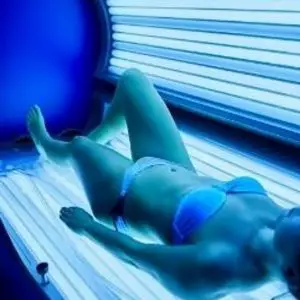We all know that UV lights can be harmful to our skin, but did you know that they can also be dangerous to your eyes? In this blog, we’ll explore the dangers of UV lights and how to protect yourself from them.
What are UV lights?
Ultraviolet (UV) light is a type of electromagnetic radiation. UV light is found in sunlight, and it can also be produced by man-made sources, such as lamps and bulbs. UV radiation is invisible to the human eye and is divided into three types: UVA, UVB, and UVC.
How do UV lights affect health?
Exposure to UV light can cause a number of health problems, including skin cancer, eye damage, and suppressed immune system function.
There are three types of UV light: UVA, UVB, and UVC. All types can kill bacteria, but UVB is more effective. UVC is the most effective type of UV light, but it is also the most dangerous to human health. This is why UVC lights are never used in public spaces.
UV lights work by turning the DNA in bacteria, viruses and other organisms so that they can no longer reproduce. In order for this to happen, the UV light must be at a certain wavelength and have a certain amount of energy.
What are the dangers of UV lights?
There are several dangers associated with exposure to UV radiation, including:
- Skin cancer: UV radiation is the main cause of skin cancer.
- Eye damage: UV radiation can damage the cornea and retina, and can cause cataracts.
- Suppression of the immune system: Exposure to UV radiation can decrease the body’s ability to fight off infections.
- Premature aging: UV radiation can cause premature wrinkles, age spots, and dryness of the skin.
UVA rays are the longest and can penetrate the skin’s outer layer, causing premature aging, wrinkles, and age spots. UVB rays are shorter and can cause sunburns. UVC rays are the shortest and most harmful, but fortunately they are mostly absorbed by the ozone layer and do not reach the earth’s surface.
What are the symptoms of UV light exposure?
Exposure to UV light can cause a number of skin reactions, such as sunburn, tanning, freckling, and photoaging. It can also lead to more serious conditions, such as skin cancer.
Symptoms of UV light exposure include:
- Redness and inflammation of the skin (sunburn).
- Itchiness
- Rash
- Blisters
- Peeling skin
- Dryness and cracking of the skin
- Changes in skin color, such as tanning or freckling.
- Premature aging of the skin (photoaging).
- Eye irritation, such as redness, watering, and pain.
How can you protect yourself from UV light exposure?
You can protect yourself from UV radiation by staying out of the sun during peak hours (10am-4pm), wearing protective clothing, and using sunscreen with an SPF of 30 or higher.
What are the treatments for UV light exposure?
There are a few treatments available for those who have been overexposed to UV light, but they should be administered as soon as possible after exposure for the best results.
The most common treatment is called phototherapy, which involves exposing the skin to controlled amounts of UV light. This helps to stop the production of melanin, the pigment that causes the skin to darken. Other treatments include medications that can help to lighten the skin, laser therapy, and surgery.
How can you prevent UV light exposure?
There are a few ways to prevent or reduce your exposure to UV lights:
- Wear clothing that covers your skin. Long-sleeved shirts, pants, and skirts can help protect you from UV rays.
- Look for clothing made from tightly woven fabrics. This type of fabric will block more UV rays than loose weave fabric.
- Wear a hat with a brim. A hat will protect your face, head, ears, and neck from UV rays.
- Use umbrellas and other shading devices. These can provide additional shade and protection from UV rays.
- Stay in the shade as much as possible, especially between 10 a.m. and 4 p.m., when the sun’s rays are the strongest.
- Use sunscreen with SPF 15 or higher, and put it on 30 minutes before going outside. Don’t forget to apply it to all exposed skin, including your lips, ears, hands, and the back of your neck
What are the long-term effects of UV light exposure?
Exposure to UV rays can cause long-term damage to the skin, including wrinkles, brown spots, and an increased risk of skin cancer.
Most people are aware of the dangers of spending too much time in the sun, but many don’t realize that exposure to artificial sources of UV light can be just as harmful. Indoor tanning beds, for example, emit high levels of UV radiation and are associated with an increased risk of skin cancer.
UV light penetrates the skin and damages the DNA inside cells. The most common types of skin cancer associated with UV exposure are basal cell carcinoma and squamous cell carcinoma, which tend to be less aggressive than other types of skin cancer. Melanoma, a more aggressive form of skin cancer, is also linked to UV exposure.
How to prevent UV skin damage
Wearing sunscreen with an SPF of 30 or higher is one way to protect your skin from UV damage. You should also limit your time in the sun, especially during peak hours when the sun’s rays are strongest (generally between 10am and 4pm). Seek shade whenever possible, and wear protective clothing, such as long sleeves and a hat, when you’re outside.
People who have fair skin or who sunburn easily are at a higher risk for developing skin cancer from UV exposure.
In Closing
UV lights certainly come with many benefits, however, they do produce UV radiation. Everyone is susceptible to the harmful effects of UV radiation, so it’s important to take steps to protect yourself from exposure.
NEXT UP: Are Mosquitos Attracted to UV Light?

